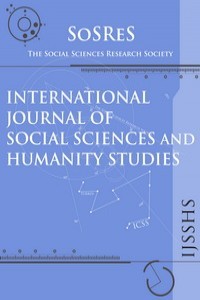MODELLING INTENTION TO VISIT WORLD MONUMENT FUNDED SITE
MODELLING INTENTION TO VISIT WORLD MONUMENT FUNDED SITE
___
- Abubakar, Abubakar Mohammed, (2016), “Does eWOM influence destination trust and travel intention: a medical tourism perspective”. Economic ResearchEkonomska Istraživanja, Vol 30, No 1, pp 598-611.
- Ajzen, Icek. (1991), “The theory of planned behavior” Organizational Behavior and Human Decision Processes, Vol 50, No 2, pp 179-211.
- Albarq. N Abbas.(2013), “Measuring the Impacts of Online Word-of-Mouth on Tourists’ Attitude and Intentions to Visit Jordan: An Empirical Study”, International Business Research, Vol 7, No 1, pp 14-22.
- Barclay, D.W., Thompson, R. and Higgins, C. (1995), “The partial least squares (PLS) approach to causal modeling: personal computer adoption and use an illustration”. Technology Studies, Vol 2, No 2, pp 285-309.
- Cain, Meghan, Zhang, Ziyong, & Yuan, Kei Hai. (2016), “Univariate and multivariate skewness and kurtosis for measuring non-normality: Prevalence, influence and estimation”, Behavior Research Methods, doi:10.3758/s13428-016- 0814-1
- Chatterjee, Patrali., (2001), “Online reviews: do consumers use them?”, In: Gilly, M.C., MyersLevy, J. (Eds.), ACR 2001 Proceedings. Association for Consumer Research. Provo, UT, pp. 129–134.
- Chen, Yu Chen., Shang, Rong An., & Li, Ming Jin. (2014), “The effects of perceived relevance of travel blogs’ content on the behavioral intention to visit a tourist destination”, Computers in Human Behavior, Vol. 30, pp. 787–799.
- Diamantopoulos, Adamantios. and Siguaw, Judy. .A. (2006), “Formative versus reflective indicators in organizational measure development. A comparison and empirical illustration”, British Journal of Management, Vol. 7,No. 4, pp. 263 - 282.
- Faul, Franz., Erdfelder, Edgar., Lang, Albert.-George., and Buchner, Axel. (2007), “G*Power 3: A flexible statistical power analysis program for the social, behavioral, and biomedical sciences”, Behavior Research Methods, Vol. 39,pp. 175-191.
- Fishbein, Martin., and Ajzen, Icek. (1975), Belief, attitude, intention and behavior: An introduction to theory and research, Reading, MA: Addison-Wesley.
- Fornell, Claes. & Larcker, David. F. (1981). Evaluating structural equation models with unobservable variables and measurement error. Journal of Marketing Research, 18(1), 39–50.
- Gefen, David., Rigdon, Edward. E., and Straub, Detmar. (2011), “An Update and Extension to SEM Guidelines for Administrative and Social Science Research. MIS Quarterly”, Vol. 35, No. 2, iii-A7.
- Gholami, Roya., Sulaiman, Ainin., Ramayah, Thurasamy. and Molla, Alemayehu. (2013), “Senior managers’ perception on green information systems (IS) adoption and environmental performance: results from a fild survey”, Information and Management, Vol. 50, No. 7,pp. 431-438.
- Han, Heesup., Meng, Bo., & Kim, Wansoo (2017), “Emerging bicycle tourism and the theory of planned behavior, Journal of Sustainable Tourism”, Vol. 25, No2,pp. 292-309, DOI: 10.1080/09669582.2016.1202955.
- Hair, Joseph. F., Thomas, G., Hult, M., Ringle, Cristian. M., and Sarstedt, Marko. (2017). A Primer on Partial Least Squares Structural Equation Modeling (2nd ed.). Thousand Oakes, CA: Sage.
- Henseler, Jorg., Ringle, Cristian. M., & Sarstedt, Marko (2015), “A new criterion for assessing discriminant validity in variance-based structural equation modelling” , Journal of the Academy of Marketing Science, Vol. 43, No. 1, pp. 115-135
- Jalilvand, Mohammad Reza. and Samiei Neda. (2012), “The Effect of electronic word of mouth on brand image and purchase intention: An empirical study in the automobile industry in Iran” , Journal of marketing Intelligence & Planning, Vol. 30, No. 4, pp. 460-476.
- Kline, Rex. B. (2011). Principles and practice of structural equation modeling. New York: Guilford Press.
- Luo, Qiuju and Zhong, Dixi.(2015), “Using social network analysis to explain communication characteristics of travel-related electronic word-of-mouth on social networking sites”, Tourism Management, Vol. 46, pp. 274-282.
- Miao, Yulin (2015), “The influence of electronic-wom on touristss’ behavioral intention to choose a destination: a case of chinese touristss visiting thailand”, Au -GSB-E Journal, Vol. 8, No. 1, pp. 113-31.
- Ringle, Cristian .M., Wende, S., & Becker, Jan-Micheal. (2015). SmartPLS 3, www.smartpls.com.
- Podsakoff, M. Philip and Mackenzie, Scott .B. (2003), “Common method biases in behavioral research: a critical review of the literature and recommended remedies”, Journal of Applied Psychology, Vol.88, No. 5, pp. 879-903.
- Shen, Suyan., Schüttemeyer, Anke and Braun, Boris (2009), “Visitors' intention to visit world cultural heritage sites: an empirical study of suzhou, china”, Journal of Travel & Tourism Marketing, Vol. 26, No. 7, pp. 722-734.
- Xiaofei Zhang., Xitong, Guo., Kee-hung. Lai, Feng. Guo, and Chenlei Li, BS. (2014), “Understanding Gender Differences in m-Health Adoption: A Modified
- Theory of Reasoned Action Model”, Telemedicine and e-Health. Vol. 20, No.1, pp.39-46.
- Kim, Soujung., Lee, Joonghwa and Doyle Yoon (2015), “Norms in Social Media: The Application of Theory of Reasoned Action and Personal Norms in Predicting Interactions With Facebook Page Like Ads”, Communication Research Reports, Vol. 32, No.4, pp. 322-331, DOI: 10.1080/08824096.2015.1089851.
- Başlangıç: 2009
- Yayıncı: Sosyal Bilimler Araştırmaları Derneği
MODELLING INTENTION TO VISIT WORLD MONUMENT FUNDED SITE
Tuan Mastiniwati Tuan MANSOR, Abdul Hafaz NGAH
THE USE OF HISTORICAL BUILDINGS FOR TOURISTIC PURPOSES: THE CASE OF KARATAY MADRASAH
Elif Merve YILMAZ, Mine ULUSOY
LEVEL OF ATTRACTIVENESS OF BEACH TOURISM OBJECT IN SIJUK DISTRICT, BELITUNG REGENCY, INDONESIA
Wahyu Widi ASTUTİ, Dewi SUSİLONİNGTYAS S.Sİ, M.Sİ, Yuliyanti MAULİDA
IS GENDER AND EDUCATION OF TOURISTS’ DETERMINANT FOR VALUE PERCEPTIONS?
Bekir Bora DEDEOĞLU, Fulden Nuray KÜÇÜKERGİN, Kemal Gürkan KÜÇÜKERGİN
A QUALITY ASSESSMENT STUDY ON THE EAST COAST ROAD OF TAMIL NADU, INDIA
Velmurugan PASUPATHİ, Dr. B. GEORGE
MOBILITIES: ITS SCOPE AND REFLECTIONS ON TURKISH TOURISM STUDIES
Yalçın ARSLANTÜRK, Bahadır İnanç ÖZKAN
